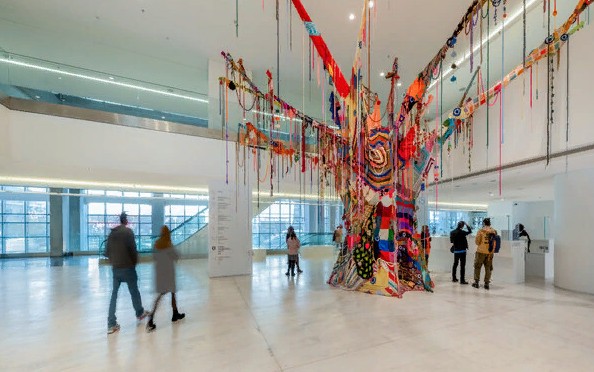«Sea, sun, and sex, with some Greek columns in the backdrop,» Poka Yio, the Athens Biennale’s artistic director, stated. As he escorted a guest around a rambling former department store that was one of the venues of the 2021 edition, he was summarizing the Greek government’s tourist activities of the 2000s. «We intended to put Athens on the modern art cultural map,» he remarked, explaining why the biennale was founded in 2007.
After fifteen years, Athens is still in the international art scene, albeit as a curiosity rather than a significant hub. 40,000 people visited the month-long Biennale, which ran from October to November, despite the pandemic. 10,000 people arrived from outside Greece, according to the organizers, and the Greek city was brimming with world-class exhibitions, including the Neon Foundation’s 59-artist group display «Portals» in a recently refurbished former tobacco factory.
«If the political powers realized how much Athens is being spoken about as a contemporary cultural destination, they could pay more attention,» Katerina Gregos, director of the National Museum of Contemporary Art, or EMST, said. But, she continued, contemporary art is still a relatively new phenomenon in Greece. «For a long time, we’ve been living in the shadow of the Acropolis,» she explained.
Gregos was referring to the cultural domination of Greece’s classical legacy, which gets the majority of the sector’s state financing. Gregos was born in Greece and was the founding director of the Deste Foundation until taking up the EMST role last summer.
She explained, «It’s understandable.» «It’s a huge duty when you have such a wonderful cultural heritage to protect, and we’re a small country with few resources.» «The contemporary Greek nation-state was built on classical concepts,» she continued, «therefore this consciousness is part of our identity.»
As a result, she claims, there has been minimal government support for contemporary visual art, with no financing body comparable to the Arts Councils of England, Canada, or Australia, and no state-funded institution to encourage individual artists. Instead, private foundations such as the Deste, Neon, Onassis, and Stavros Niarchos Foundations fill the need by awarding grants, hosting artist residencies, and hosting exhibitions.
«By building an ecology, the big foundations have played a huge role in altering attitudes toward contemporary art,» Yio added. «Athens also has another distinguishing feature: modest efforts. Because it’s so cheap, a lot of people are coming here now to open creative spaces.» He went on to say that the appearance in 2017 of the every-five-year Documenta show — the first time the major art world event had been held outside of Germany — was a game-changer.
Regardless of their success, these private-sector initiatives do not «substitute the necessity for a public policy,» according to Gregos.
Recently, the Greek government appears to have come to an agreement. Nicholas Yatromanolakis, a Harvard graduate, was named secretary for modern culture in July 2019, before being promoted to the culture minister’s deputy, responsible for contemporary culture, at the start of 2021.
The 46-year-old Yatromanolakis, speaking at his office in the graffiti-strewn central Athens neighbourhood of Excharcheia, said that modern culture has not historically been considered as a substantial contribution to the economy or as crucial to Greece’s worldwide image and soft power.
«The pandemic had a significant impact on the contemporary industry, and I believe the prime minister understood the need to invest more in that area,» he said.
One of Yatromanolakis’ initial goals was to get EMST up and running as soon as possible. The museum, which opened in 2000, was a nomadic enterprise for 15 years before settling inside a 1957 former brewery in central Athens. Even still, extensive delays in construction and financing, which are often regarded as signs of systemic dysfunction, meant it wasn’t completely operating until early 2020, just before the coronavirus pandemic.
Gregos was asked by the culture ministry to oversee the museum at about the same time. She was both enthusiastic and apprehensive about the proposal, she said, because the Greek economic crisis, which began in 2009, had resulted in substantial cuts in government spending across the board. She did, however, accept. She described it as «Greece’s flagship institution for modern art.» «You won’t find a more interesting or demanding career anywhere.»
In Greece, contemporary cultural projects receive between a quarter to a third of the culture budget, which has averaged roughly $400 million over the last seven years, while classical heritage sites receive the rest. When shared over heritage projects, national theatres and museums, and contemporary culture, it’s a little sum, according to Yerassimos Yannopoulos, a lawyer and EMST board member. (For reference, France’s culture budget is estimated to be over $4 billion.)
«The prime minister is highly supportive of this notion of supporting contemporary culture, and Nicholas Yatromanolakis is a bright man,» he continued, «but Greece has been in a bad condition since the debt crisis.» «You can’t turn things around by keeping to the wonderful archaeological past,» he continued.
However, Yatromanolakis believes that binary thinking is ineffective. He stated, «I believe pitting the classical against the contemporary is unproductive.» «It should be collaborative,» he added, citing a 2019 exhibition on Delos island featuring works by British artist Antony Gormley among ruins and antique antiquities as an example.
Yatromanolakis followed up with data on state funding for small-scale contemporary projects, which showed a significant increase from roughly half a million dollars in 2015 to around $11 million in 2020. He also mentioned further European Union monies from the Recovery and Resilience Facility, which offers another half a billion euros to Greece’s culture sector, evenly divided between heritage and contemporary projects, to help alleviate the impact of the epidemic.
The lack of attention on modern culture in Greece, according to Afroditi Panagiotakou, director of culture at the Onassis Foundation, was the driving force for the establishment of the Onassis Cultural Center. That structure, which houses two theatres and exhibition rooms, first opened its doors in 2011. «We were in the midst of an economic crisis, and the Greek government just lacked the resources,» she explained.
But, she warned, successful sponsorship of modern art takes more than simply money. «Ultimately, the artists are the ones that transform the atmosphere,» she remarked. «Our job is to help them, to collaborate with them, to be there for them.»
Yatromanolakis cited the Stavros Niarchos Foundation Cultural Center, which houses the Greek National Opera and Ballet, and the Onassis Foundation’s support for a new Acropolis elevator as examples of private foundations working closely with the state. «It’s not a competition,» he stated emphatically.
He went on to say that the most ambitious topic on his list was labour and social reform for freelance artists, whose requirements aren’t addressed by current tax and employment laws. «If we don’t change that, culture experts won’t be able to make a living from their employment,» he warned. «There was nothing in place for contemporary culture,» Yatromanolakis explained, «so you have to start from scratch.» «Despite all of the terrible consequences of the epidemic, I believe we can utilize this as a turning point in how we conduct things.»
According to Yio, the Biennale director, Athens may lack financial clout, but it is a developing metropolis, «a counterpoint to the London-Paris-Berlin triangle,» because of its stream of migrants and artists. He went on to say that Greeks have never had a «bourgeois sense» of art.
«We’ve been missing modernism here, and we’re now attempting to make great leaps,» he explained. «We lack many of the processes and structures found in other countries.» But this is also a very good thing, and it’s part of what makes Athens so appealing. In this location, anything is still conceivable.»




Be the first to comment on "‘Under the Shadow of the Acropolis,’ Athens is creating a new art hub"